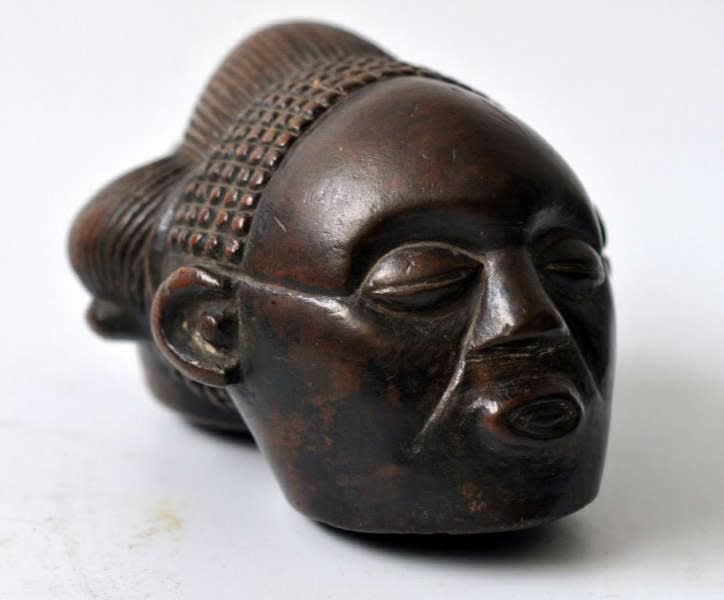
The above royal Luba cup probably can be crowned as the discovery of 2013. It was sold at a small European auction at the end of last year. The estimate being € 7,5-10K, it was hammered down for € 130.000 ! Not suprisingly, since cups shaped like human heads with twin drinking receptacles on their underside are among the rarest of Luba royal insignia. This example is very close to a cup sold by Sotheby’s in 2010 for € 161K. A third is in the Berlin Museum für Völkerkunde (purchased from Hermann Haberer in 1925) and a fourth cup was published in Utotombo (Brussels, 1988: p. 232, #219). Most cups of this type have emanated from Kanyok people and perhaps related groups to the west of the Luba heartland. The Sotheby’s cup has been attributed to a workshop in the Kalundwe region (Felix 1987: 48-49; Neyt 1993: 212), not far from the Luba heartland, as evidenced by certain formal attributes. Some additional pictures:
In the Sotheby’s catalogue, Mary Nooter Roberts made some interesting remarks about the function of these cups:
Luba cups of this sort were documented by the late Albert Maesen, former Head of the Ethnography Section at the Royal Museum of Central Africa in Tervuren, who conducted research and a collecting mission in southern Belgian Congo in the 1950s. Maesen reports that among the Kanyok, royal drinking vessels were the only objects he was not permitted to see in a storeroom in which the ruler’s emblems were guarded, including thrones and scepters. He was allowed to view the rectangular box in which the cups were kept, but he was informed that they were only used during a ruler’s investiture and for other sacred occasions (A. Maesen, personal communication, 1987).
Maesen found that royal cups called musenge were also used in a ceremony to honor paternal ancestral spirits, when a titleholder made an offering of cooked cassava while the ruler communed with his ancestors. The chief counselor named Shinga Hemb drank palm wine from one side of the cup and then passed it to the participants who drank from the other side. Similar acts were performed after divination or at the rising of a new moon (A. Maesen, personal communication, 1982).
The secrecy associated with these royal cups and their limited number suggests another possible association: Early colonial sources and oral traditions point to the importance of the skull of the previous ruler to the investiture of his successor. The skull was the vehicle through which the new ruler obtained power, blessing, and wisdom from his predecessor and validated his own link in the chain of political and moral authority. Quiet contemplation with the skull was essential to investiture, and some writers assert that the king consumed human blood from the cranium, to effect his transformation from an ordinary human being to a semi-divine ruler (Verbeke 1937: 59; Van Avermaet and Mbuya 1954: 709-711; Theuws 1962:216). Indeed, the Luba word for royalty, bulopwe,” refers to “the status of the blood” (Roberts and Roberts 2007:32). It has been asserted that carved wooden cups might have replaced and symbolized the use of skulls in important rituals (Huguette Van Geluwe, personal communication, 1982). Such an assertion remains a hypothetical explanation for the existence of these beautifully carved and carefully concealed cups.



